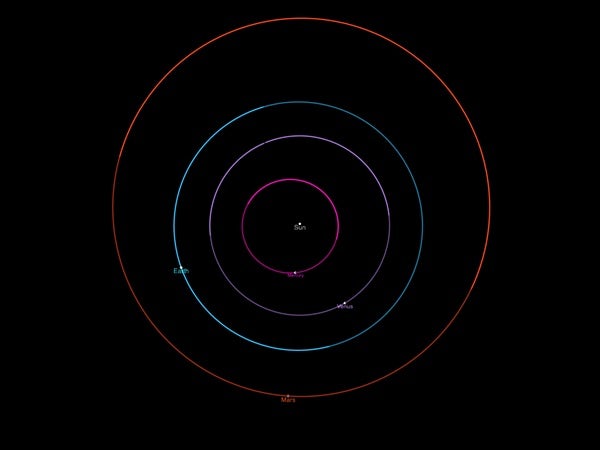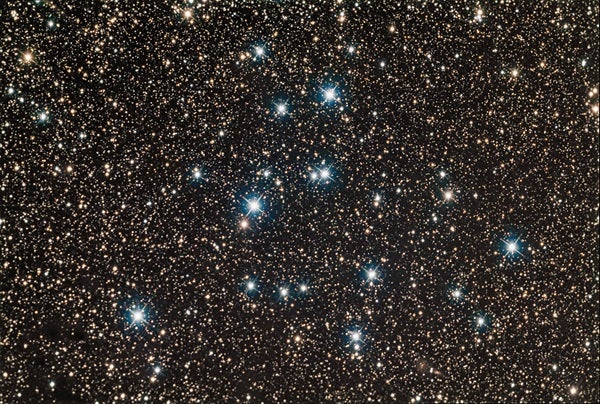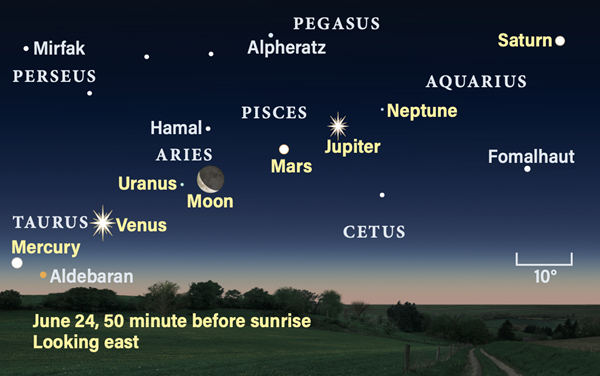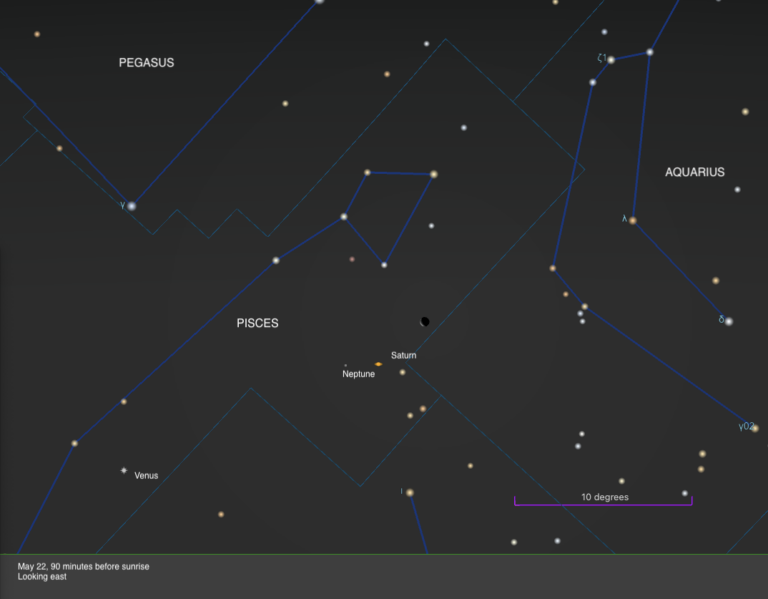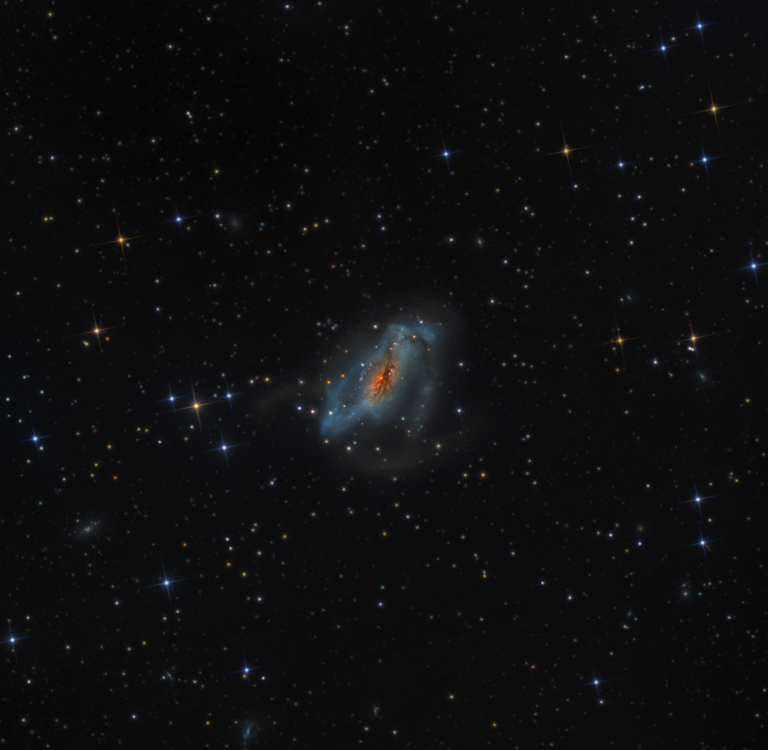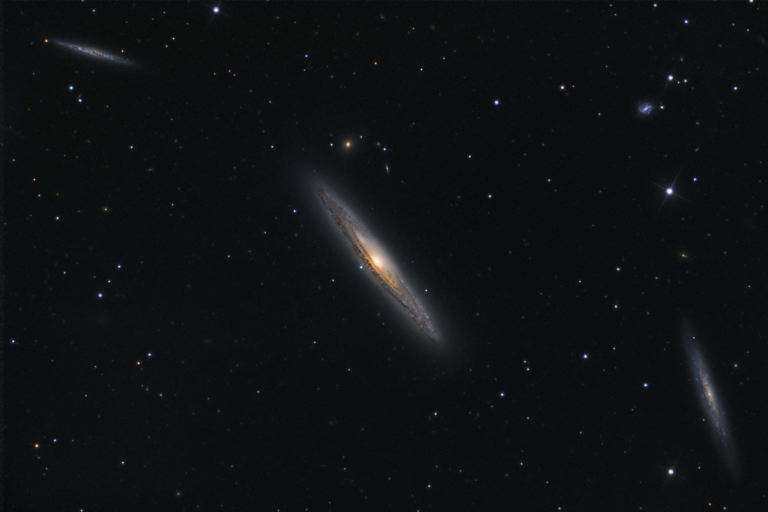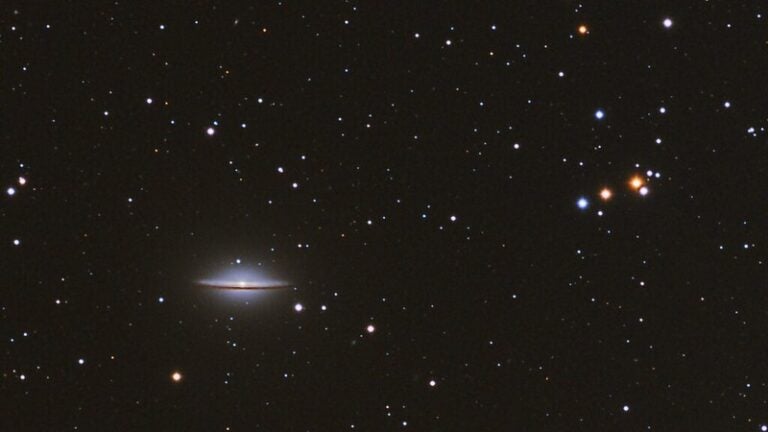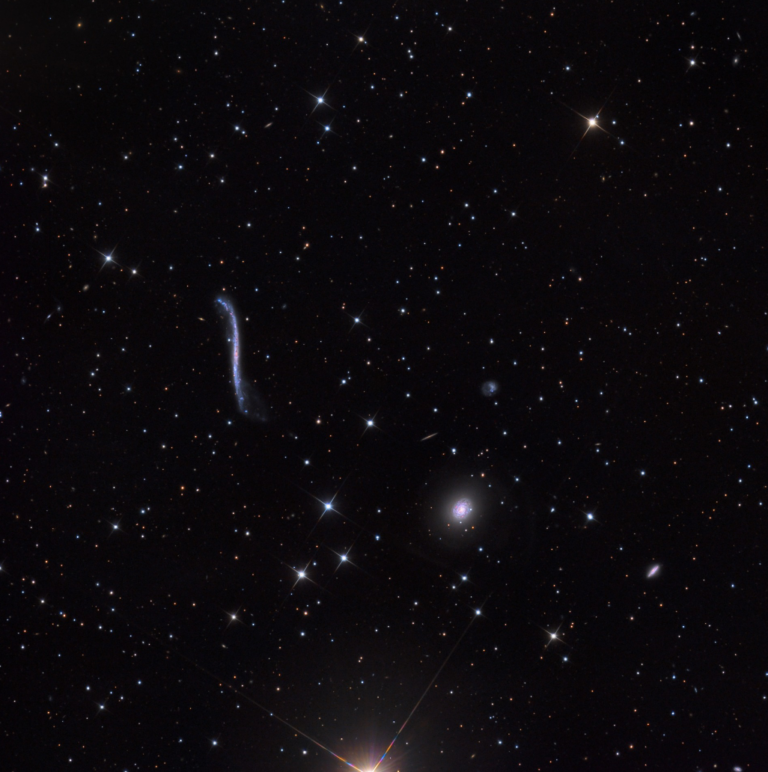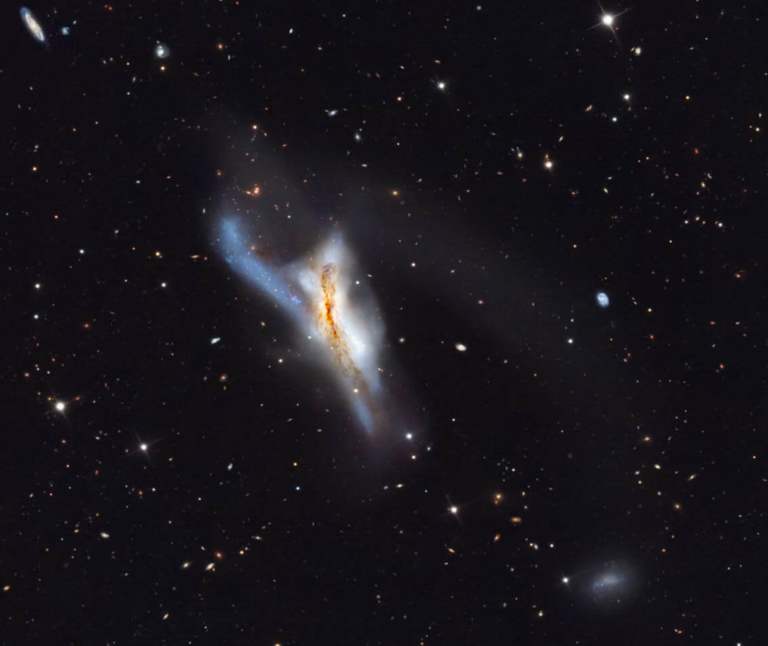Friday, June 17
Comet C/2017 K2 (PanSTARRS) is now around mid-9th magnitude and brightening, according to the Comet Observation database. The comet is perfectly poised for evening viewing tonight with a 4- to 6-inch scope, rising in the east with the stars of Ophiuchus the Serpent-bearer as the Sun sets. An hour after sunset, the comet is already 30° high and climbing, just over 2.5° east-northeast of magnitude 2.8 Cebalrai (Beta [β] Ophiuchi). The view only gets better as this region continues to rise in the darkening sky.
And tonight, there’s an added bonus: Some 1.5° due west of the comet is IC 4665, a 4th-magnitude open star cluster that spans roughly 40′ on the sky. It’s a picture-perfect view for astrophotographers looking to capture the comet near a stunning partner. Compare and contrast the cluster’s soft glow to the fainter comet, which should have a distinct, fan-shaped tail. In just two days, PanSTARRS’ tail will appear edge-on from Earth, then slowly start to extend out to the other side.
Sunrise: 5:31 A.M.
Sunset: 8:31 P.M.
Moonrise: 11:59 P.M.
Moonset: 8:49 A.M.
Moon Phase: Waning gibbous (85%)
*Times for sunrise, sunset, moonrise, and moonset are given in local time from 40° N 90° W. The Moon’s illumination is given at 12 P.M. local time from the same location.
Saturday, June 18
The Moon passes 4° south of Saturn at 8 A.M. EDT. Both sit in eastern Capricornus and rise shortly after 12 A.M. local time this morning. By 4 A.M. local time, they’re 30° high and just over 6° apart, with the 3rd-magnitude star Deneb Algedi caught between them. Saturn is magnitude 0.5 and may be a bit hard to find in the glare of our nearby satellite.
Several other naked-eye planets have come out to play as well, stretching east along the ecliptic (left of Saturn). From west to east (right to left) are Jupiter (magnitude –2.3), Mars (magnitude 0.5), Venus (magnitude –3.9), and, rising around 4:20 A.M. local time, Mercury (magnitude 0.4). You’ll notice these planets are lined up in order of distance from the Sun, from nearest (Mercury) to farthest (Saturn). Interspersed between them are the binocular planets Uranus (magnitude 5.9, 7.5° west of Venus) and Neptune (magnitude 7.8, 10.8° west of Jupiter).
That’s right: All the major planets lie in the morning sky right now, giving us a view across the solar system for the rest of the month, until Mercury drops out of view in early July. Plus, this Friday (the 24th), the alignment gets even better as the Moon moves from its current position to its rightful place in line between Mercury and Venus. Make sure to keep an eye on the morning sky as our satellite slides east day by day.
Sunrise: 5:31 A.M.
Sunset: 8:31 P.M.
Moonrise: —
Moonset: 10:06 A.M.
Moon Phase: Waning gibbous (76%)
Sunday, June 19
The Moon, moving east along the ecliptic, passes 0.7° south of asteroid 4 Vesta at 4 A.M. EDT. Our satellite now lies in Aquarius, its gibbous phase making it difficult to spot the 7th-magnitude main-belt world, though patient observers with binoculars or a telescope may still find it. Despite being numbered fourth (denoting it was the fourth asteroid discovered), Vesta is the second most massive object in the main belt, behind dwarf planet 1 Ceres. It’s also roughly as large as Saturn’s moon Enceladus. The Dawn spacecraft visited Vesta from 2011 to 2012, studying the asteroid’s composition before the mission moved on to its final destination, Ceres.
If you have trouble spotting Vesta this morning, just wait a few days for the Moon to wane and move on, which should let you spot the fainter world by using 3rd-magnitude Skat as a jumping-off point — just look about 5° northwest of this star for the next several days.
Sunrise: 5:31 A.M.
Sunset: 8:32 P.M.
Moonrise: 12:33 A.M.
Moonset: 11:20 A.M.
Moon Phase: Waning gibbous (65%)
Monday, June 20
Moving along the ecliptic, the Moon passes 4° south of Neptune at 1 P.M. EDT. The ice giant lies in Pisces the Fish, about 8° directly below (southeast of) an asterism called the Circlet. There are seven stars in this unofficial pattern: Gamma (γ), 7, Theta (θ), Iota (ι), 19, Lambda (λ), and Kappa (κ) Piscium. And the Circlet itself lies 12° south of another asterism: the Great Square of Pegasus, formed by Beta (β), Alpha (α), and Gamma Pegasi, as well as Alpha Andromedae. (Yep, you read that right: The Great Square of Pegasus contains a star in the constellation Andromeda.)
You can’t see Neptune’s dim glow (magnitude 7.8) with the naked eye but binoculars or a small telescope should show it, although the Moon will cast the background sky a lighter black or gray than usual. The planet’s disk is just 2″ wide and may appear a bluish gray; it will also look “flatter” than any nearby field stars.
Last Quarter Moon occurs at 11:11 P.M. EDT, as our satellite continues to rise later each morning.
Sunrise: 5:31 A.M.
Sunset: 8:32 P.M.
Moonrise: 1:01 A.M.
Moonset: 12:29 P.M.
Moon Phase: Waning gibbous (55%)
Tuesday, June 21
The summer solstice occurs at 5:14 A.M. EDT, marking the beginning of summer in the Northern Hemisphere and the beginning of winter in the Southern Hemisphere. On this day, the Sun sits 23.5° above the equator, on a line drawn parallel to the equator and called the tropic of Cancer.
Mars reaches perihelion — the closest point to the Sun in its orbit — today at 9 A.M. EDT. The Red Planet now sits 128 million miles (206 million kilometers) from our star and is some 125 million miles (202 million km) from Earth. Climbing high in the eastern sky before sunrise, magnitude 0.5 Mars currently lies in southeastern Pisces, 13.5° east of Jupiter (a much brighter magnitude –2.3). Through a telescope, Mars’ disk appears 7″ across and is 86 percent lit.
Glance west of Mars to focus in on Jupiter, which sits about 4.5° north-northeast of the waning crescent Moon in the hours before dawn. The Moon will pass 3° due south of Jupiter at 10 A.M. EDT. All four of the gas giant’s Galilean moons sit to its west today, although depending on when you look, their order may change. Early on the 21st, Europa sits closest to Jupiter, with Io the next farthest out. Around 3 A.M. EDT, the two moons pass each other, with Io northwest of Europa. After this time, Io will sit closest to Jupiter, with Europa farther out. Callisto and Ganymede lie farther west, in that order.
Sunrise: 5:32 A.M.
Sunset: 8:32 P.M.
Moonrise: 1:25 A.M.
Moonset: 1:35 P.M.
Moon Phase: Waning crescent (44%)
Wednesday, June 22
The Moon continues to meander its way along the ecliptic, passing 0.9° south of Mars at 2 P.M. EDT. But let’s take advantage of the moonless skies this evening to enjoy some of the many treasures in Cygnus the Swan, which is rising in the east at sunset and flies high overhead late overnight and into the early morning hours of the 23rd.
M39 is an open cluster located 9° northeast of bright Deneb (Alpha Cygni, magnitude 1.3). Glowing at magnitude 4.6, naked-eye observers can likely spot it from a dark location once the constellation is relatively high above the horizon. The cluster spans about half a degree and is relatively close to Earth — just 800 light-years distant. According to Astronomy columnist Phil Harrington, although M39 itself contains relatively few stars (some 30 stars within a span of 7 light-years), it’s the cluster’s surroundings that make a truly spectacular view. Because it lies in such a richly populated region of the Milky Way, the nearby cluster can appear three-dimensional against the background of numerous fainter stars.
Next, try for M29: a fainter, 7th-magnitude grouping of stars less than 2° south-southeast of Sadr (Gamma Cygni, magnitude 2.2). Through smaller binoculars, this 7′-wide cluster may look more like a soft rectangular glow. Bump up your binoculars or switch to a small telescope to resolve its stars, laid out in a pattern that Harrington likens to the Pleiades’ dipper shape.
Sunrise: 5:32 A.M.
Sunset: 8:32 P.M.
Moonrise: 1:48 A.M.
Moonset: 2:39 P.M.
Moon Phase: Waning crescent (34%)
Thursday, June 23
Mercury passes 3° north of Aldebaran, the bright red eye of Taurus the Bull, at 10 A.M. EDT.
The early-morning sky is likely familiar by now, with a long line of planets stretching along the ecliptic. Mercury is the last to rise, peeking above the eastern horizon roughly an hour before the Sun. Magnitude 0.9 Aldebaran follows a few minutes later and the two rise together as dawn approaches.
By about 40 minutes before sunrise, Mercury and Aldebaran are 4.5° high. If your eastern horizon is clear or you can get to an elevated location, you should have a good view. To the pair’s upper right is blazing Venus, also in Taurus, which sits 5.5° south-southeast of the Pleiades. These stars disappear quickly in the brightening sky, but because Venus rises about an hour earlier than Mercury, you can catch the cluster and the planet together in a darker sky.
A delicate crescent Moon hangs southeastern Pisces, now just over 7.5° east of Mars.
Sunrise: 5:32 A.M.
Sunset: 8:33 P.M.
Moonrise: 2:11 A.M.
Moonset: 3:42 P.M.
Moon Phase: Waning crescent (25%)
Friday, June 24
If you’re only willing to get up early one morning this week, it should be today: Early risers now have a unique view out across the solar system in the predawn sky, as the five classical planets — plus our Moon — line up in order of distance from the Sun.
By about 50 minutes before sunrise, the entire tableau is on display, stretching some 106° along the ecliptic. Let’s start with Mercury, which is last to rise and now glows at magnitude –0.1 about 3.7° above the horizon. The small planet sits 3.5° northeast of Aldebaran, whose orangey light may just be visible in the growing twilight.
Next is Venus, 10° west of Mercury. It’s the brightest of the lot by far at magnitude –3.9. Venus now hangs nearly 6° southeast of the Pleiades, while the thin crescent Moon, next in line from the Sun, lies in Aries the Ram, 20° west of Venus.
Then comes Mars, now nearly 19.5° west of the Moon and still glowing at magnitude 0.5. Jupiter, which has brightened slightly to magnitude –2.4, is 15.5° west of Mars, right at the border between Pisces and Cetus. It’s sitting about 16° directly above 3rd-magnitude Dheneb (Eta [η] Ceti, not to be confused with Deneb [Alpha Cygni] in Cygnus). And topping off our view across our star system is magnitude 0.5 Saturn, 42° west of Jupiter and located just northeast of Deneb Algedi in Capricornus.
Situated between the naked-eye planets are the ice giants, meaning every single planet is visible this morning if you’ve got some binoculars on hand. Uranus’ dim, tiny disk sits in Aries the Ram, located between Venus and the Moon. It’s some 6° east of our satellite before dawn; the Moon will pass 0.05° due south of Uranus later today at 6 P.M. EDT. Neptune’s magnitude 7.8 disk is 11.5° west of Jupiter this morning, located in western Pisces.
Sunrise: 5:32 A.M.
Sunset: 8:33 P.M.
Moonrise: 2:35 A.M.
Moonset: 4:44 P.M.
Moon Phase: Waning crescent (17%)



